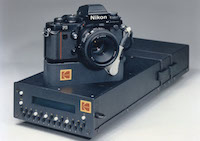Throwback Thursday: Early Kodak DSLR takes a trip to space in 1991
posted Thursday, April 17, 2014 at 10:05 AM EST

Here’s a little Throwback Thursday action, taking us to a time when Kodak was a trailblazing force in digital photography, the US had an active space shuttle program, eyeglasses covered half your face, and digital SLRs were the future.
In 1991, NASA sent a Kodak Hawkeye II on space shuttle mission STS-44, making it the first digital camera in space. The system was essentially a modified Nikon F3 with a 1.3-megapixel CCD sensor (and the associated circuitry) replacing the film back, attached to a processing unit and a mammoth lead-acid power supply via 20-pin connector, all tethered to a 100MB hard drive. Memory cards are much smaller these days, and even the cheapest cameras have about 10 times the resolution. But they had to start somewhere, and it was by far the best solution at the time.
In this clip, dug up by Nikon Rumors, one of the astronauts shows off the gear, describing how it enabled them to view their photos, right after they were captured, by hooking up the hard disk to a monitor in the shuttle. The purpose for the cameras seems to have been to take telephoto shots of the ground while the shuttle was in orbit—with the assistance of a 300mm lens strapped to a 1.4x and 2x teleconverter. A giant radio antenna also transmitted the images back to mission control.
By the time of the mission, Kodak had already announced the first commercially available digital SLR system, the Kodak DCS, which was basically a refined, polished version of the Hawkeye II. But bringing the Hawkeye on a mission was a signal that NASA took the technology seriously, which couldn’t have hurt its prospects among the general public. It also helped cement the equipment's place in history, as it did with the Hasselblad cameras that went to the moon. Kodak was so far ahead of any other competitor when it came to digital photography, and the film business was still as good as printing money. It's a cautionary tale for any company that thinks their lead is so great that they need not change with the times and technology.
The history of these cameras is well documented—particularly by Jim McGarvey, lead engineer at Kodak during much of the transition into the digital era. Check out his archives for more on the camera, and other early Kodak digital SLRs.
(Via Nikon Rumors)